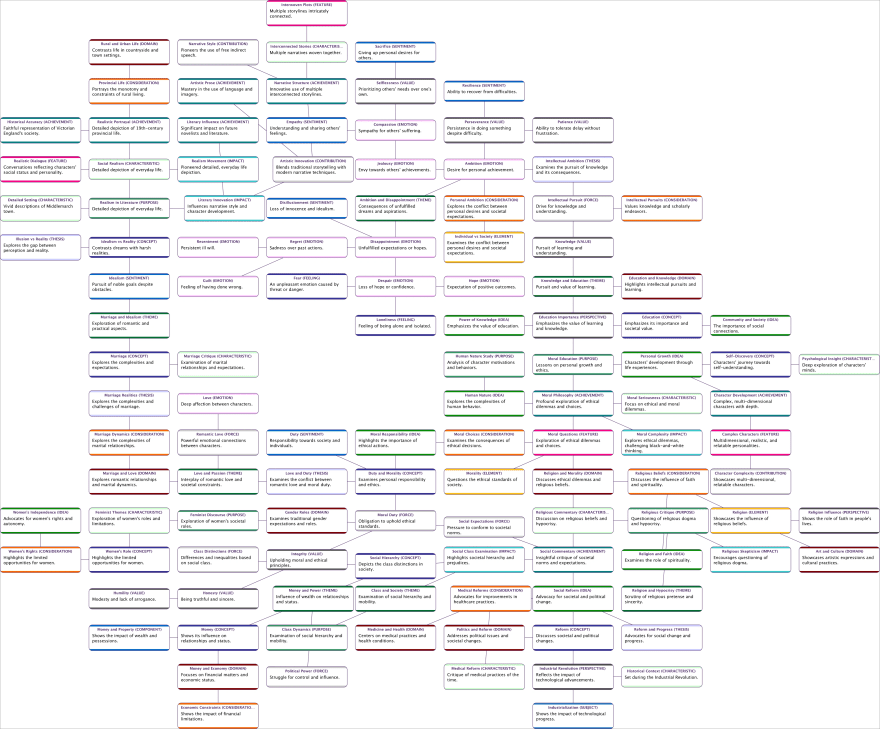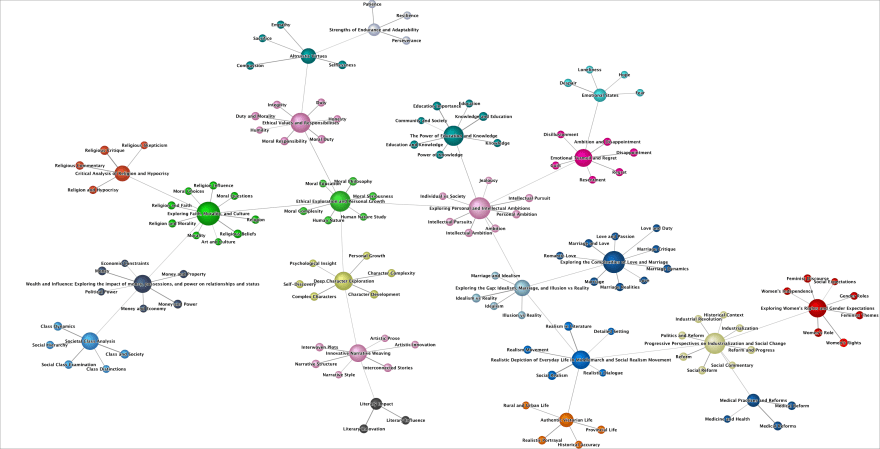George Eliot: Middlemarch (1871)

Immerse yourself in George Eliot’s “Middlemarch,” a literary masterpiece that profoundly looks into 19th-century provincial life in England. Leveraging the capabilities of Hellixia, our journey into this classic will be navigated through semantic networks, dividing our exploration into two distinct stages:
Narrative Analysis: By examining the plot intricacies, character dynamics, and the socio-personal currents influencing them, we’ll draw deeper connections within the narrative.
Holistic Analysis: Stepping back from the immediate narrative, Hellixia will guide us through a broader examination of the novel. Tapping into diverse categories such as Achievements, Emotions, Themes, and Values, we aim to capture the multifaceted essence of “Middlemarch.”
Join us in this exploration, where we aim to unravel the nuances and complexities of “Middlemarch” that continue to resonate with readers across generations.
Narrative Analysis
From the unfolding Events to pivotal Milestones and distinct Locations to underlying Motifs, we’ll spotlight the interwoven Relationships among the novel’s Entities. Guided by essential keywords like Context, Developments, and Progressions, this section seeks to unveil the narrative depth and intricacies of Eliot’s masterpiece.
Workflow for Creating the Semantic Network
- Start by creating the node “Middlemarch.”
- Use the Dimension Elicitor, employing the keywords “Context, Developments, Entities, Events, Keywords, Locations, Milestones, Motifs, Progressions, and Relationships,” to conduct an exhaustive narrative analysis of the book. Set the General Context to “George Eliot novel”.
- Inspect the dimensions returned by Hellixia and eliminate any that seem superfluous or unrelated to your analysis. Next, disregard the “Middlemarch” node and run the Embedding Generator on all remaining nodes to apprehend the semantic associations of their names and comments.
- Use the Maximum Weight Spanning Tree algorithm to generate a semantic network.
- Change node styles to Badges to ensure each node’s comment is visible. Then, apply the Dynamic Grid Layout to position the nodes on your graph; remember that this algorithm is not deterministic, and its orientation—vertical, horizontal, or mixed—is random. You might need to execute this layout several times to obtain an arrangement that aligns with your taste.
- Switch over to Validation Mode
F5and select Skeleton View. Since your network doesn’t represent causal relations, Skeleton View will maintain only node connections without indicating a direction.

Workflow for the Node Force analysis
- Return to Modeling Mode
F4and change the node styles to Discs.
- Use the Symmetric Layout and switch to Validation Mode
F5to run a Node Force analysis.

Workflow for creating the Hierarchical Semantic Network
- Execute Variable Clustering: This operation will categorize analogous variables based on semantic relationships.
-
Open the Class Editor and run Class Description Generator to generate descriptive names for the factors in question. Use the Export Descriptions function, and save the newly created descriptions. - Return to Modeling Mode
F4and run Multiple Clustering to generate latent variables. -
Run the structural learning algorithm Taboo. Ensure the “Delete Unfixed Arcs” option is enabled.
- Use the descriptions you exported earlier as a Dictionary to rename the latent variables you’ve created.
- Switch to Validation and run Node Force.

Holistic Analysis
Transitioning from the narrative details, our next phase delves into the broader essence of “Middlemarch.” Here, we venture beyond the story to understand its Achievements, Emotions, Themes, and Values, capturing the multifaceted heart of Eliot’s work. This comprehensive exploration offers a panoramic view of the novel’s enduring impact and significance.
Follow the workflow outlined in the Narrative Analysis section, but use this set of keywords: Achievements, Characteristics, Components, Concepts, Considerations, Contributions, Domains, Elements, Emotions, Features, Feelings, Forces, Ideas, Impacts, Perspectives, Purposes, Sentiments, Subjects, Themes, Theses, and Values.
Semantic Network

Node Force analysis

Hierarchical Semantic Network

